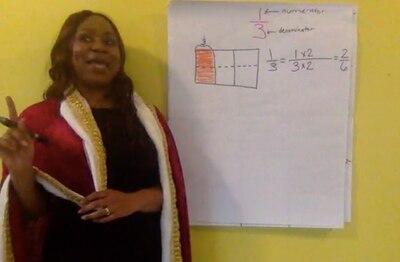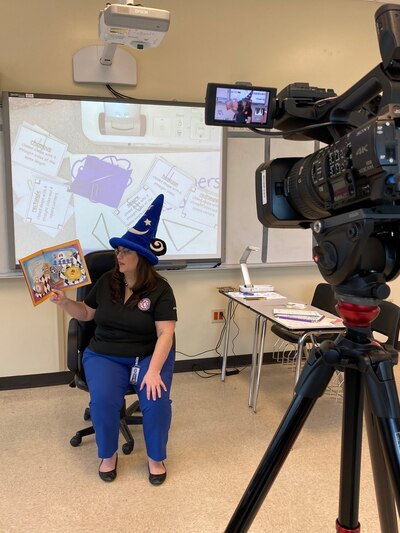In some ways, teaching for TV requires the same skills classroom teaching does: maintaining high energy to keep students’ attention and honing in on state requirements for learning. There are even the same dry erase boards.
But for Shelby County Schools educators used to classroom teaching, this new set-up takes some getting used to. Some recorded their lessons from home facing a computer screen, while others recorded from someone else’s classroom facing a TV camera. At Middle College High School, one classroom has been transformed into a makeshift studio.
Then, there’s the lack of student interaction, which is the hardest part for Keiya Graves-Garrett, a math teacher advisor in the district’s Innovation Zone, made up of low-performing schools.
“A lot of times we make adjustments to our instruction based on responses of scholars,” she said. “When we’re doing video, we’re not able to determine that they definitely have it.”
With campuses closed in an effort to curb the spread of the new coronavirus, Memphis educators last week prepared and recorded 23 ready-for-TV lessons for students in all grade levels and in subjects, including English, math, social studies, and science. More of these lessons will soon make their way to broadcast.
A partnership with Memphis TV news station WMC is a part of the district’s effort to rely on resources that don’t require an internet connection, since not all students have one, to reach more children while they are out of school amid the pandemic. The videos are produced by and also broadcast on Shelby County Schools’ TV station C19, Voice of SCS.
While many school districts across the nation have turned to online classes, Memphis leaders worried that would leave out many students. About 72% of Memphis households have internet access at home — the second lowest rate in the nation, among large cities in 2017. In some areas of the city, just 55% of households are connected to the internet, according to U.S. Census data.
Related: With schools shuttered, Memphis leaders weigh budget demands from digital learning to staff cuts

For Graves-Garrett’s 30-minute lesson, geared to fourth graders, she started with a question that siblings arguing over snacks could likely relate to: Is half the brownies the same as five-tenths of the brownies? She drew and kept notes on a poster-size notepad and explained how to find equivalent fractions. At times she paused for up to a minute to let students ponder an answer or write down their observations and questions. And when it came time to solve the problem, she brought out her red “thinking cape.” She closed with a reminder for children to wash their hands, among other health safety tips to prevent COVID-19 from spreading.
Broadcasts like this one are meant to reinforce and build on skills students were learning before the school closures, rather than replace the classroom experience and supports, district leaders say. None of the work prompted by the TV lessons will be graded. The same goes for paper and online instruction Shelby County Schools has provided families in recent weeks.
Before recording, teachers and administrators reviewed each other’s lessons and gave feedback on the presentation via video conferencing as each tried to think through what would need to be adjusted for a TV audience. Some teachers also had a captive audience at home to practice on, as their own children adjust to the city’s stay-at-home order.
Heba Sammour, an early literacy advisor, said her colleagues helped her figure out how to transition from teaching one skill to another by adding “Great job!” and “Kiss your brain!” even though she couldn’t actually check the students’ work.

Her two children, one in pre-K and the other in kindergarten, also served as test cases in pacing her lesson. “I would ask them a question and see how long it would take them to write it,” she said. “That definitely helped me.”
The lessons started airing Thursday, March 26 and are available online and on the TV station’s app after airing. The daily schedule is announced on the station’s morning newscasts and posted daily on the station’s Facebook and Twitter pages. The channels are Bounce 5.2 on antenna TV, Comcast 906, and Dish 6.
Of the Memphis households that watch TV, up to 7%, or about 41,200 households, were tuned to WMC during any given quarter-hour in November, according to Nielsen, which conducts ratings for TV stations. But in the past month, more viewers nationwide are turning to local TV stations for news during the pandemic, Nielsen found. Most notably, the number of children watching TV news has spiked by 20%.
Related: Tennessee enlists PBS for home lessons as governor recommends closing schools another month
Antonio Burt, the district’s chief academic officer, said the impact of losing one day of instruction for higher-performing districts is roughly the equivalent of losing three days of instruction for a district like Shelby County Schools, where test scores are well below the state’s average. For the TV lessons, Burt’s team chose state standards that are weighed heavily on the annual exam and that students have struggled with in the past.
“If students come back to school, whenever they come back, we also will be basically running two simultaneous school years,” he said. “That’s why we want to be intentional, have targeted areas of focus to address, know those standards that are the major work of every grade to ensure students get a lot of repetition.”
Michael Lowe, the district’s equity officer who has recorded an eighth-grade social studies and English lesson, said it’s hard to replace students and instructors talking out the lesson in real-time, but it is important to facilitate learning while school is out.
This is “the best chance we have to getting as close as possible to a real, live classroom experience,” he said. “Every day they are not learning, we have to catch up.”

